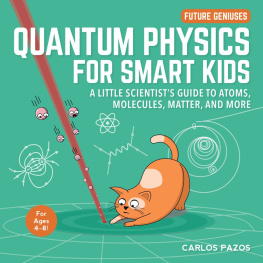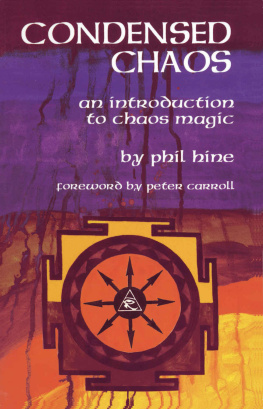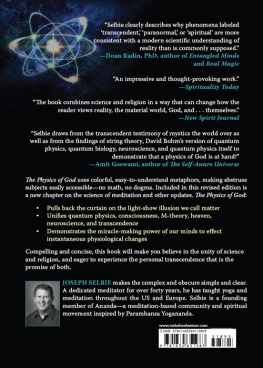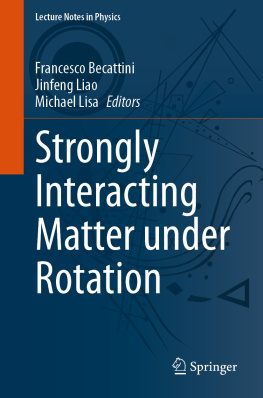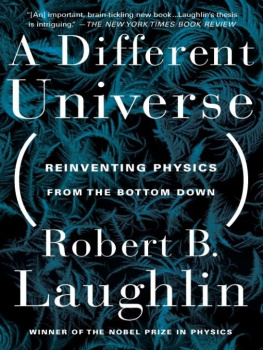Contents
Guide
The Magick of Physics
Uncovering the Fantastical Phenomena in Everyday Life
Felix Flicker, PhD
I The Physics of Dirt

T he wizard, Veryan, whispered into her crystal the familiar incantation as she clambered through the cold, dark cavern. With a puff of breath, as if to release the seeds of a dandelion, she awakened in the stone a dazzling red light that illuminated the moss-covered rocks around her.
After walking for some time, she found herself at an entrance. Her passage was barred by a vast wooden door held together with wide iron joists. Working in the harsh light of the crystal, she felt her way to the doors handle, a thick, black iron ring. She pulled, but the ring held: the door was locked. Finding the edge of the wood, she pressed her fingers into the small gap between the door and its surrounding and found the doors bolt, made of the same rough iron as the handle.
She spoke again to the crystal in her practiced, quiet tone and it gradually dimmed. After a few seconds, she found herself once again in perfect darkness. Positioning herself in front of the bolt, she rested the crystal flat on her palm, offering it to the door like grass to a horse and uttering a few syllables of the old tongue, more sharply this time. The light returned as an intense red heat, a focused, narrow beam. Piercing the gap, the stream of light cleaved through the bolt, leaving in its wake the red-orange glow of molten iron, the noxious smell of the blacksmiths forge cutting through the air. The light vanished as quickly as it had appeared. She pulled again at the ring; with effort, the door eased open. As it did, light and life began to seep in through the widening crack from the dry stone staircase on the other side. Her task was about to begin.
This is a book about wizardry. It will reveal the secret ways of the wizards art, and how you, too, can learn to follow them. It is also a history of magic, telling how, by a process of observing the world, wizards deduced the spells they castand how modern wizards continue to develop new magic to transform the world before our very eyes.
The modern name for magic is physics, and the name for a wizards magic is condensed matter physics. Before we discuss what these names convey, you must understand that this book comes with a warning. Once you have learned how a spell is cast, the effect of the spell will cease to appear to you as magic. It will become mundane. Everyday. Boring. This is the cost of magical knowledge. It will take a great deal of practice, and patience, for you to regain the sense of wonder you had when the magic was first performed for you.
Throughout most of historyeven within living memorythe story you just read would surely have been the stuff of fantasy. If you could produce from your pocket a crystal able to light a cavern at your request, then magic must be at work, and you must surely be a wizard. Yet these days such an action is mundane: an LED, a light-emitting diode, is a crystal, and by passing electricity through it you can cause it to light at the flick of a switch. A laser diode, also a crystal, creates an intense light that, when focused, can cut through solid metal. Now you probably feel cheated. Theres no magic in using an LED flashlight. Using an LED flashlight is boring! Magic requires a certain incomprehensibility and unfamiliarity. LED flashlights are boring because theyre familiar, and because, at one level or other, you understand how they work. But if you showed the flashlight to someone in the Middle Ages, they would certainly think it was magical because its technology would be unfamiliar. With enough time you could explain it to them. As you did, and as they gained familiarity, it would cease to appear magical. But would it really have lost its magic? Or is that just an illusion?
It takes work to see the magic in the familiar, but its there. Physics is a program to rationalize and understand the world. Many things that would once have been considered magic are now routine. Yet our understanding tends to advance in increments, building on existing knowledge. You may find a joke funny forever, but you can only get it once. But understanding the joke allows you to perform it for others. With skill in the telling, and a little luck, a joke will have on others the effect it once had on you. So it is with magic. The secret to learning the worlds magicto learning physicsis to laugh continuously at the cosmic joke. Its the difference between seeing a conjurer perform a trick and having the trick explained. Hopefully, when you first meet some of the ideas in this book, they may invoke in you that sense of magic. And hopefully, when youve read the book, you will understand where those ideas came from, and they will seem more natural. You may have to work to maintain the sense of magic they once held, but by learning a spell you can cast it to the benefit of others.
The Rules of Wizardry
Now that youre heeding the warning, lets talk about wizards. When I refer to wizards, Im thinking, like, classic wizards. People who do magic. Id say the defining characteristics of a wizard are something like this. We can call them the Rules of Wizardry:
- A wizard studies the world.
- A wizard understands that they are a part of the world they are studying.
- A wizards understanding leads them to see hidden patterns and connections that others do not.
- A wizards knowledge is of a practical, hands-on kind.
- A wizard can cause changes to the world, but they make such changes sympathetically (see Rule 2).
Sometimes a wizards study is academic, like Harrys and Hermiones at Hogwarts. Sometimes the study is a quiet contemplation, as with Rey or Yoda in Star Wars, sages in classic Daoist texts such as the Zhuangzi, or martial artists such as Katara and Aang in the epic TV series Avatar: The Legend of Aang. Often the study takes the form of exploring and experiencing the world, as with Gandalf in The Lord of the Rings, Morgana and Merlin in Arthurian legend, and Tenar and Ged in Ursula K. Le Guins classic Earthsea novels. In many modern examples, the wizard is a supernaturally gifted scientist. Doc Browns achievements in Back to the Future, Ricks in Rick and Morty, or those of Doctor Who are presented as scientific, but the technology is so far beyond the experiences of the other characters and the audience that it is more like magic. It is apparent that the Rules of Wizardry implicitly assume an important hidden rule, the Rule of Rebellion:
A wizard understands that rules are made to be broken.
Look again at the five and a half rules of wizardry, and replace the word wizard with scientist. That seems about right, doesnt it? J. G. Frazer, in his chronicle of magical practices, The Golden Bough, put it poetically:
Magic like science postulates the order and uniformity of nature; hence the attraction both of magic and of science, which open up a boundless vista to those who can penetrate to the secret springs of nature.
Frazers quote makes a link between magic and science. But wizardry is a particular type of magic; a particular type of science. And its name is condensed matter physics


